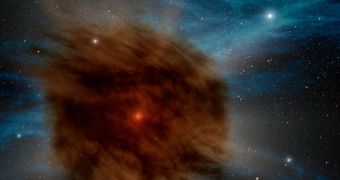A group of astronomers believes it may have discovered a new and interesting cosmic event, in which massive stars go supernova not in a massive bang, but rather by fizzling out inside a dust cocoon.
The cosmic dust is apparently capable of smothering the star to death, investigators believe, adding that this type of phenomenon was more common in the early days of the Universe.
Scientists based at the Ohio State University (OSU) say that usually, when a star reaches the end of this burning cycle, it tend to shed the outer layers of its atmosphere violently.
These explosions are among the most violent events that can take place in the Universe, as light from supernova explosions can briefly outshine entire galaxies.
A structure called a planetary nebula is usually left behind after the massive star explodes. But the recently-found event, the first of its kind to be observed, showed none of these characteristics.
The OSU group says that the supernova was discovered in August 2007, as experts were carrying out the NASA Spitzer Space Telescope Deep Wide Field Survey.
The researchers were in fact looking for cosmic structures known as active galactic nuclei (AGN), which are basically supermassive black holes that are located at the very core of galaxies.
In a paper published online in the latest issue of the esteemed Astrophysical Journal, OSU astronomy professor Christopher Kochanek, the leader of the research team, explains how the finding was made.
He says that the supernova was discovered in a distant galaxy that is located some 3 billion light-years away from Earth. The expert said that this stellar explosion released much of its energy as heat.
This is uncommon for supernova, astrophysicists say, because supermassive black holes are the structures that generally produce that type of heat.
As matter gets sucked towards the event horizon, it accumulates in a structure called the accretion disk, in which tremendous friction raise the temperatures to tens of thousands of degrees.
In the distant galaxy, the team discovered a heat signature that couldn't have come from a black hole, and concluded that a dust-smothered supernova must be causing it, said Szymon Kozlowski, who was a postdoctoral student at OSU at the time.
“Over six months, it released more energy that our Sun could produce in its entire lifetime,” Kozlowski said.
“We think the outer shell must be nearly opaque, so it absorbed any light energy that made it through the inner shell and converted it to heat,” Kochanek adds.
Funds for this investigation came from NASA and the US National Science Foundation (NSF).

 14 DAY TRIAL //
14 DAY TRIAL //